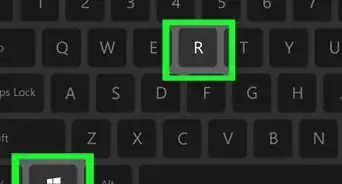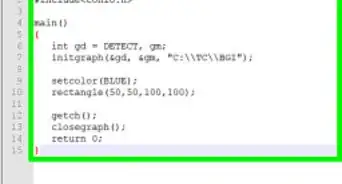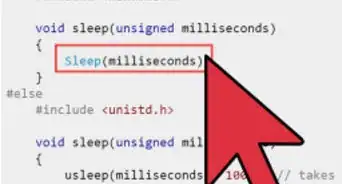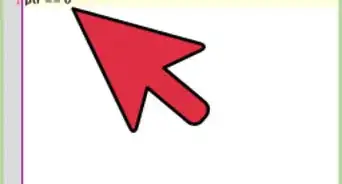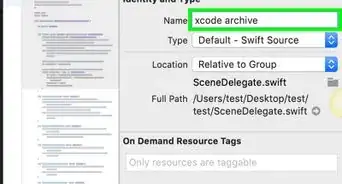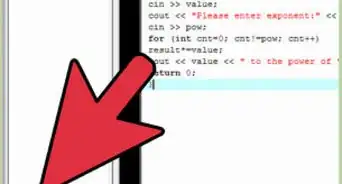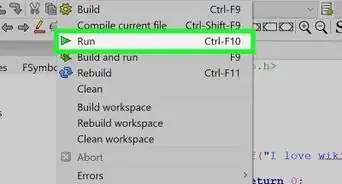This article was co-authored by wikiHow staff writer, Nicole Levine, MFA. Nicole Levine is a Technology Writer and Editor for wikiHow. She has more than 20 years of experience creating technical documentation and leading support teams at major web hosting and software companies. Nicole also holds an MFA in Creative Writing from Portland State University and teaches composition, fiction-writing, and zine-making at various institutions.
This article has been viewed 106,879 times.
Learn more...
Whether you're a novice C++ programmer or a veteran software developer, graphics programming is an educational and rewarding experience. Simple DirectMedia Layer (SDL) is a C++ compatible library that allows simple, low-level access, to the graphics functionality of a variety of platforms. This wikiHow teaches you how to install and set up SDL with Visual Studio 2022. It configures OpenGL. This guide will assume your platform is Windows 10 or 11. It is addressing the beginner, save last 3 Parts. He learns how to set up SDL in project with Visual Studio by 3 ways: 1st targeting x32 platform, 2nd targeting x64 platform, and 3rd set up SDL source compiled by CMake and Visual studio. By default Visual Studio 2022 is x64 application. However it run interchangeably x86 (32 bits) and x64 applications.
Steps
Configuring Visual Studio
-
1Highlight what you expect to do. Highlight step or sub-step you expect to do and then do it. See as example picture above.
-
2Download Visual Studio 2022. If you have not done so you can download it from https://www.visualstudio.com/downloads.
- Check the Desktop development with C++ workload box as you download. If necessary scroll down the page (see below image).
- Click "Language pack" and check "English" box.
- During installing, in "Personalize your Visual Studio experience" wizard, in "Development settings" menu click "General" > click "Visual C++" > hit Start Visual Studio.
Downloading SDL
-
1Create folders GL and GLP. Open Windows's File Explorer > Navigate to disk (directory) C.
- If folders GL and GLP exist it's okay.
- If they do not, right click in empty area > select New > Folder > type GL > hit ↵ Enter. By same way create folder GLP.
-
2Download the latest version of SDL2. Right click on the following link and select Open Link in New Window https://github.com/libsdl-org/SDL/releases/tag/release-2.26.0. Scroll to the bottom. Click version (see image above) SDL2-devel-2.26.0-VC.zip (Visual C++ 32/64-bit) or latest.
- In downloading window you have the folder SDL2-2.26.0, (or the last version). Click it > right click > select Copy.
- Navigate to C:\GL. Inside GL, right click > select Paste.
- Click on name SDL2-2.26.0, (or the last version), > right click > select "Rename" > type SDLbin > hit ↵ Enter. Now in folder GL you have folder SDLbin.
- (Alternatively, open "Files Explorer" window > C: > GL. Go to downloading window > click downloaded folder and drag into C:\GL > rename to SDLbin).
- Close downloading window.
Creating Project Targeting x32 Platform
-
1Create empty project.
-
If Visual Studio is not open. Open it > click Create a new project > find (see image above, if necessary scroll down the list. Icon is different than in image, it doesn't matter though) Empty Project Start from scratch with C++ for Windows. Provides no starting files., click it > click Next.
- In "Project name" text field type (or copy and paste) SDLx32-0
- In "Location" text field delete everything > copy C:\GLP\ > paste.
- Check "Place solution and project in the same directory" > click Create. Wait till Visual Studio instance with project SDLx32-0, appears.
- If Visual Studio is open. Click File > New > Project… . The rest as above.
-
If Visual Studio is not open. Open it > click Create a new project > find (see image above, if necessary scroll down the list. Icon is different than in image, it doesn't matter though) Empty Project Start from scratch with C++ for Windows. Provides no starting files., click it > click Next.
-
2Add your Source file to the project.
- In "Solution Explorer" window right click the "Source Files" folder (the last one) > click "Add > "New Item…"
- Copy Main.cpp > in the "Add New Item" wizard delete "FileName.cpp" > paste > click Add. The file will open in the main text editor but leave the file blank for now.
Setting Up SDLx32 in Project
-
1Configure project's Properties. In "Solution Explorer" right click on the name of your project, that is SDLx32-0 (in image it is different, it doesn't matter), and select "Properties". In "SDLx32-0 Property Pages" wizard,
-
1. Main menu. In Configuration: select Active(Debug) > Platform: Win32 or x86 > click Configuration Manager.
- "Configuration Manager" wizard
- In "Active solution platform:" select x86 or Win32
- In "Platform", Win32 or x86 is automatically selected
- Click Close.
- "Configuration Manager" wizard
-
2. Additional Include Directories. See below images. Open the C/C++ drop-down menu. Click General > Additional Include Directories > down arrow at the right of the field > click <Edit...>
- Copy C:\GL\SDLbin\include > in "Additional Include Directories" wizard click first icon > paste.
- In "Additional Include Directories" wizard click OK.
-
3. Additional Library Directories Open the "Linker" drop-down menu (see below image), and click "General" > click "Additional Library Directories" entry > down arrow at the end of the field > "Edit".
- Copy C:\GL\SDLbin\lib\x86 > in "Additional Library Directories" wizard click first icon > paste.
- In "Additional Library Directories" wizard click OK.
-
4. Additional Dependencies In the "Linker" drop-down menu (see below image), click "Input" > the "Additional Dependencies" entry > down arrow at the right of the field > "Edit".
- Copy opengl32.lib; SDL2.lib;SDL2main.lib > paste in "Additional Dependencies" wizard's most-top text box.
- In "Additional Dependencies" wizard click OK.
- 5. System. In the "Linker" drop-down menu (see below image), click "System" > "SubSystem" > down arrow > select "Console (/SUBSYSTEM:CONSOLE)" from the dropdown menu. Click Apply > OK on the "SDL-0 Property Pages" wizard.
-
1. Main menu. In Configuration: select Active(Debug) > Platform: Win32 or x86 > click Configuration Manager.
-
2Add dll file path (address) to "System Variables". In Windows search box on the taskbar (bottom left of the screen) type envir > hit ↵ Enter. "System Properties" wizard is thrown.
- Select the "Advanced" tab from the top bar > click Environment Variables.... "Environment Variables" wizard is thrown.
- Double click the "Path" (or "PATH") Variable in the "System Variables" section. "Edit environment variable" wizard is thrown.
- Copy C:\GL\SDLbin\lib\x86 > click New > Paste.
- Click OK in all 3 wizards.
- Close Visual Studio > in thrown wizard "Save changes to the following items?" click Save.
- Restart your PC > open Visual Studio. If project is open, it's okay. If it's not, in "Open recent" list, click "SDLx32-0.sln" the first one. Now your project is open ready for test.
Testing project and Correcting errors
-
1Test your project. Copy following code and paste in Main.cpp code area > in main menu select x86 > hit Ctrl+F5. If a black window with message "SDL initialization succeeded!" appears, then the project was set up correctly. You are now ready to program with SDL.
#include <iostream>
#include <SDL.h>
using namespace std;
int main(int argc, char * argv[])
{
if (SDL_Init(SDL_INIT_EVERYTHING) < 0)
{
cout << "SDL initialization failed. SDL Error: " << SDL_GetError();
}
else
{
cout << "SDL initialization succeeded!";
}
cin.get();
return 0;
}
-
1Correct errors. Files are missing. Copy C:\GLP\SDLx32-0 and paste in File Explorer Address Bar. You should see file you added Main.cpp, and 4 other files added by Visual Studio. If they are missing you missed add file Main.cpp. Go to Part 3, step 2, and add it now.
- In "Error List" if you see error
- cannot open file SDL.h, go to previous Part, step 1, Configure project's Properties, sub-step 2. Configure "Additional Include Directories" and follow instructions. Also check whether folder SDLbin exists in C:\GL.
- cannot open file SDL2.lib or SDL2main.lib, go to previous Part, step 1, sub-step 3. Configure "Additional Library Directories" and follow instructions. Also to sub-step 4. Configure "Additional Dependencies".
- "entry point must be defined" go to previous Part, step 1, sub-step 5. Configure "System" and follow instructions.
- Thrown wizard about System or dll file, go to previous Part, steps 2 and 3, and follow instructions
- For other errors. Check whether you have added source file. If you cannot correct them, close Visual Studio > delete project folder SDLx32-0 which lives in C:\GLP > open Visual Studio > repeat set up from Part 3. Good job.
- In "Error List" if you see error
Creating Project with SDLx32-0 Template
-
1Create template. Go to Visual Studio (see below image) and, while "SDLx32-0" is open, click "Project" > "Export Template...". On "Export template Wizard" check "Project Template", if it's not checked. Click Next >.
- On Select Template Options, for Template name: If it is "SDLx32-0" it's okay. If it's not, copy SDLx32-0 and paste .Output Location: (something like C:\Users\utilisateur\Documents\Visual Studio 2019\My Exported Templates\Project-1.zip) is okay. Click Finish. Template has been created. Delete the thrown window with template's path.
-
2Create project. In Visual Studio main menu, click File > New > Project....
- In Create a new project wizard select SDLx32-0 (if necessary scroll down the list of templates) > click Next.
- In Configure your new project wizard, if "Project name" is SDLx32-01 it's okay. If it's not, copy SDLx32-01 and paste.
- Location should be C:\GLP, if it's not, copy C:\GLP and paste > Be sure Place solution and project in the same directory is checked > click Create.
- In Visual Studio's GUI main menu, select x86 > hit Ctrl+F5. If a black window with message "SDL initialization succeeded!" appears, then the project was set up correctly. You are now ready to program with SDL.
- TIP. When you create project with this template remember in Visual Studio main menu select x86.
Creating project to target x64 platform
-
1Create folders GL and GLP. Open Windows's File Explorer > Navigate to disk (directory) C.
- If folders GL and GLP exist it's okay.
- If they do not, right click in empty area > select New > Folder > type GL > hit ↵ Enter. By same way create folder GLP.
-
2Download SDL2. If you have not already downloaded it, go to Part 2, step 2, and download it.
-
3Create empty project.
-
If Visual Studio is not open. Open it > click Create a new project > find (see image above, if necessary scroll down the list. Icon is different than in image, it doesn't matter though) Empty Project Start from scratch with C++ for Windows. Provides no starting files., click it > click Next.
- In "Project name" text field type (or copy and paste) SDLx64-0
- In "Location" text field delete everything > copy C:\GLP\ > paste.
- Check "Place solution and project in the same directory" > click Create. Wait till Visual Studio instance with project SDLx32-0, appears.
- If Visual Studio is open. Click File > New > Project… . The rest as above.
-
If Visual Studio is not open. Open it > click Create a new project > find (see image above, if necessary scroll down the list. Icon is different than in image, it doesn't matter though) Empty Project Start from scratch with C++ for Windows. Provides no starting files., click it > click Next.
-
4Add your Source file to the project.
- In "Solution Explorer" window right click the "Source Files" folder (the last one) > click "Add > "New Item…"
- Copy Main.cpp > in the "Add New Item" wizard delete "FileName.cpp" > paste > click Add. The file will open in the main text editor but leave the file blank for now.
Installing SDLx64-0 in the Project
-
1Project's Property Pages. Go to "Solution Explorer" > right click on the name of your project SDLx64-0 > select "Properties". In SDLx64-0 Property Pages wizard,
-
1. Main menu: In Configuration entry select Active(Debug) > in Platform: entry, select x64 > Click Configuration manager...
- In Configuration Manager wizard, in Active solution platform: select x64
- In Platform entry, x64 is selected automatically.
- Click Close
-
2. Additional Include Directories: See below images.
- In SDLx64-0 Property Pages window double click C/C++ > click General > Additional Include Directories > down arrow at the end of the field > click <Edit...>.
- Copy C:\GL\SDLbin\include and paste in Additional Include Directories wizard's upper-most text field.
- In Additional Include Directories wizard click OK.
-
3. Additional Library Directories: In the "SDLx64-0 Property Pages" wizard, open Linker (see below image) > click General > Additional Library Directories > down arrow at the end of the field > click <Edit... >.
- Copy C:\GL\SDLbin\lib\x64 and paste in Additional Library Directories wizard's upper-most text field.
- Click OK in Additional Library Directories wizard.
-
4. Additional Dependencies: In "Linker" drop-down menu (see below image), click "Input" > the "Additional Dependencies" entry > down arrow at the right of the field > "Edit".
- Copy opengl32.lib; SDL2.lib;SDL2main.lib and paste in top-most text box in "Additional Dependencies" wizard.
- In "Additional Dependencies" wizard click OK.
- 5. System: In Linker drop-down menu (see below image), click System > SubSystem > down arrow at the end of the field > select Console (/SUBSYSTEM:CONSOLE).
- Click Apply and then OK in "Project's Property Pages" wizard.
-
1. Main menu: In Configuration entry select Active(Debug) > in Platform: entry, select x64 > Click Configuration manager...
-
2Add dll file path (address) to "System Variables". In Windows search box on the taskbar (bottom left of the screen) type envir > hit ↵ Enter. "System Properties" wizard is thrown.
- Select the "Advanced" tab from the top bar > click Environment Variables.... "Environment Variables" wizard is thrown.
- Double click the "Path" (or "PATH") Variable in the "System Variables" section. "Edit environement variable" wizard is thrown.
- Copy C:\GL\SDLbin\lib\x64 > click New > Paste.
- Click OK in all 3 wizards.
- Close Visual Studio > in thrown wizard "Save changes to the following items?" click Save.
- Restart your PC > open Visual Studio. In "Open recent" list, click "SDLx64-0.sln", the first one. Now your project is open ready for test.
Testing SDLx64-0 project and Correcting errors
-
1Test your project. Copy following code and paste in Main.cpp code area > in main menu select x64 > hit Ctrl+F5. If a black window with message "SDL initialization succeeded!" appears, then the project was set up correctly. You are now ready to program with SDL.
#include <iostream>
#include <SDL.h>
using namespace std;
int main(int argc, char * argv[])
{
if (SDL_Init(SDL_INIT_EVERYTHING) < 0)
{
cout << "SDL initialization failed. SDL Error: " << SDL_GetError();
}
else
{
cout << "SDL initialization succeeded!";
}
cin.get();
return 0;
}
-
1Correct errors. Files are missing. Copy C:\GLP\SDLx64-0 and paste in File Explorer Address Bar. You should see file you added Main.cpp, and 4 other files added by Visual Studio. If they are missing you missed add file Main.cpp. Go to Part 7, step 4, and add it now.
- In "Error List" if you see error
- cannot open file SDL.h, go to previous Part, step 1, sub-step 2 Additional Include Directories, and follow instructions. Also check whether folder SDLbin exists in C:\GL.
- cannot open file SDL2.lib or SDL2main.lib, go to previous Part, step 1, sub-step 3 Additional Library Directories and follow instructions. Also to sub-step 4 Configure Additional Dependencies.
- "entry point must be defined" go to previous Part, step 1, sub-step 5 Configure System, and follow instructions.
- Thrown wizard about System or dll file, go to previous Part, steps 2 and 3, and follow instructions
- For other errors. If you can't correct them, close Visual Studio > delete project folder SDLx64-0 which lives in C:\GLP > open Visual Studio > repeat set up from Part 7. Good job.
- TIP: Even if in Property Pages main settings it is Platform: x64, click Configuration manager... and in Active solution platform: select x64.
- In "Error List" if you see error
Creating Project targeting x64 Platform, with Template
-
1Create template. Go to Visual Studio (see below image) and, while "SDLx64-0" is open, click "Project" > "Export Template...". On "Export template Wizard" check "Project Template", if it's not checked. Click Next >.
- On Select Template Options, if Template name: is SDLx64-0 it's okay. If it's not copy SDLx64-0 and paste. Output Location: (something like C:\Users\utilisateur\Documents\Visual Studio 2019\My Exported Templates\Project-1.zip) is okay. Click Finish. Template has been created. Delete the thrown window with template's path.
-
2Create project. In Visual Studio main menu, click File > New > Project....
- In Create a new project wizard in the list of templates select SDLx64-0 (if necessary scroll down the list) > click Next.
- In Configure your new project wizard, if "Project name" is SDLx64-01 it's okay. If it's not copy SDLx64-01 and paste. Location should be C:\GLP. If it's not, copy C:\GLP and paste.
- Be sure Place solution and project in the same directory is checked > click Create.
- In Visual Studio GUI's main menu, select x64. Hit Ctrl+F5.
- TIP: Remember in every project you create with this template, select x64 (next to Debug) in Visual Studio's GUI.
Installing Cmake
-
1Compiling a library from the source code guarantees that the resulting library is perfectly tailored for your CPU/OS, a luxury pre-compiled binaries don't always provide. It is also important that binaries you get target x64 platform.
-
2Create folders GL and GLP. Open Windows's File Explorer > Navigate to disk (directory) C.
- If folders GL and GLP exist it's okay.
- If they do not, right click in empty area > select New > Folder > type GL > hit ↵ Enter. By same way create folder GLP.
-
3Download CMake. Right-click on following address and select Open Link in New Window https://cmake.org/download/. Scroll down the page and find "Latest Release (3.25.1)", (or latest). In second "Platform" list, find (see image above) "Windows x64 ZIP" and click the beside entry cmake-3.25.3-windows-x86_64.zip (or latest) > in opening wizard select Save file.
-
4Copy and unzip the zip folder.
- If the downloaded folder doesn't contain line with stripes (unzipped folder) click it > right click > Copy.
- If downloaded folder's icon contains vertical line with stripes (zipped folder), double click it for get unzipped folder, (or alternatively, click folder > right click > in drop-down menu select Extract all).
- When unzipping (extracting files) is finished, click unzip folder cmake-3.25.3-windows-x86_64.zip (or latest) > right click > Copy.
- Go to drive (directory) C: > GL > right click > Paste.
- (Alternatively click folder "cmake-3.25.3-windows-x86_64" and drag into folder "GL").
- When copying is finished click folder "cmake-3.25.3-windows-x86_64" > right click > select "Rename" > type CMake > hit ↵ Enter > double click it > double click folder bin > inside you should see CMake's logo next to file name cmake-gui > double click this file. Now on your screen you have CMake GUI.
- Each time you need CMake, navigate to C:\ > GL > double click folder CMake > double click "bin" > double click file cmake-gui (the one with CMake's logo).
Compiling Source Code with CMake and Visual Studio
-
1Download source code. Right-click on following address and select Open Link in New Window https://github.com/libsdl-org/SDL/releases/tag/release-2.26.0. See image above. Select Source code (zip).
- Copy and unzip folder.
- In downloading window click zip folder SDL-release-2.26.0 (or latest version) > right click > select Copy.
- Navigate to C:\ > GL > right click > select Paste.
- (Alternatively click folder and drag into C:\GL).
- Now in directory C:\GL, you have unzip folder SDL-release-2.26.0 (or latest version). Click twice on its name > delete name > type: SDLsrc > hit ↵ Enter.
- Copy and unzip folder.
-
2Compile source by Cmake and Visual Studio. See above image.
- Copy (attention do not copy any space)C:/GL/SDLsrc > paste in CMake GUI first text field.
- Copy (attention do not copy any space)C:/GL/SDLsrc/build and paste in the second text field.
- Configure and generate. In CMake GUI, click Configure > in wizard Create Directory click Yes > in wizard "Specify the generator for this project" click Finish.
- If, instead, wizard "Error" is thrown, click OK > click "File" > click "Delete Cache" > in thrown wizard "Delete Cache", click Yes.
- When, in CMake GUI, you read: "Configuring done", click Generate. You should read: "Generating done".
-
3Build your solution.
- Copy C:/GL/SDLsrc/build and paste in File Explorer's Address bar > hit ↵ Enter > double click "SDL2.sln", or "SDL2", or "ALL_BUILD.vcxproj". An instance of Visual Studio appears. In the main menu, click "Build" > "Build Solution".
- Wait till in "Output" window last line you read: ========== Build: X succeeded, 0 failed, 0 up-to-date, Y skipped" ==========
- TIP: Numbers X of "succeeded" and Y "skipped" change in SDL2 versions. Today (March 14, 2023) are 7 and 2 respectively.
- Close this instance of Visual Studio > close Cmake.
Creating Project SDLsrc-0
-
1Create empty project.
-
If Visual Studio is not open. Open it > click Create a new project > find (see image above, if necessary scroll down the list. Icon is different than in image, it doesn't matter though) Empty Project Start from scratch with C++ for Windows. Provides no starting files., click it > click Next.
- In Configure your new project wizard,
- Copy SDLsrc-0 and paste in "Project name", text field.
- If "Location" is "C:\GLP\" it's okay. If it's not, copy C:\GLP\ > in "Location" text field delete everything > paste.
- Check "Place solution and project in the same directory".
- Click Create.
- Wait till Visual Studio instance appears.
- In Configure your new project wizard,
- If it is open. Click File > New > Project… . The rest as above.
-
If Visual Studio is not open. Open it > click Create a new project > find (see image above, if necessary scroll down the list. Icon is different than in image, it doesn't matter though) Empty Project Start from scratch with C++ for Windows. Provides no starting files., click it > click Next.
-
2Add source file.
- In "Solution Explorer" window right click the "Source Files" folder (the last one) > click "Add > "New Item…"
- Copy Main.cpp > in the "Add New Item" wizard delete "FileName.cpp" > paste > click Add. The file will open in the main text editor but leave the file blank for now.
Setting up compiled SDL Source
-
1Configure project's Properties. In Solution Explorer wizard, right click Project's name that is SDLsrc-0 > select Properties. In 'SDLsrc-0 Property Pages wizard,
-
1. Main menu. In "Configuration:" entry select "Active(Debug)". In Platform: entry select x64 > click Configuration Manager....
- In Active solution platform: select x64.
- In Platform entry, x64 is automatically selected.
- Click Close.
-
2. Additional Include Directories. Open C/C++ entry > click General > In beside menu select the first one, Additional Include Directories > click the down arrow at the end of the field > click Edit....
- Copy C:\GL\SDLsrc\include > in Additional Include Directories wizard click first icon > paste.
- In Additional Include Directories wizard click OK.
-
3. Additional Library Directories. Open Linker entry > click General > Additional Library Directories > click the down arrow at the end of the field > click Edit....
- Copy C:\GL\SDLsrc\build\Debug > in Additional Library Directories wizard click first icon > paste.
- In Additional Library Directories wizard click OK.
-
4. Additional Dependencies. In Linker drop-down menu select Input > in beside menu select the first one, Additional Dependencies > click the down arrow at the end of the field > Edit....
- Copy opengl32.lib; SDL2maind.lib; SDL2d.lib and paste in Additional Dependencies wizard's upper-most text box > click OK.
- 5. System In Linker drop-down menu select System > in beside menu select the first one, SubSystem > click the down arrow at the end of the field > select Console (/SUBSYSTEM:CONSOLE). Click Apply and OK.
-
1. Main menu. In "Configuration:" entry select "Active(Debug)". In Platform: entry select x64 > click Configuration Manager....
-
2Add dll file path (address) to "System Variables". In Windows search text field (bottom left of the screen) type envir > hit ↵ Enter. "System Properties" wizard is thrown.
- Select the "Advanced" tab from the top bar > click Environment Variables.... "Environment Variables" wizard is thrown.
- Double click the "Path" (or "PATH") Variable in the "System Variables" section. "Edit environment variable" wizard is thrown.
- Copy C:\GL\SDLsrc\build\Debug > click New > Paste.
- Click OK in all 3 wizards.
- Close Visual Studio > in thrown wizard "Save changes to the following items?" click Save.
- Restart your PC > open Visual Studio. In "Open recent" list, click "SDLsrc-0.sln", the first one. Now your project is open ready for test.
Testing project SDLsrc-0 and Correcting errors
-
1Test your project. Copy following code and paste in Main.cpp code area > in main menu select x64 > hit Ctrl+F5. If a black window with message "SDL initialization succeeded!" appears, then the project was set up correctly. You are now ready to program with SDL.
#include <iostream>
#include <SDL.h>
using namespace std;
int main(int argc, char * argv[])
{
if (SDL_Init(SDL_INIT_EVERYTHING) < 0)
{
cout << "SDL initialization failed. SDL Error: " << SDL_GetError();
}
else
{
cout << "SDL initialization succeeded!";
}
cin.get();
return 0;
}
-
1Correct errors. Files are missing. Copy C:\GLP\SDLsrc-0 and paste in File Explorer Address Bar. You should see file you added Main.cpp, and 4 other files added by Visual Studio. If they are missing you missed add file Main.cpp. Go to Part 12, step 2, and add it now.
- In "Error List" if you see error
- cannot open file SDL.h, go to Part 13, step 1, sub-step 2 Additional Include Directories, and follow instructions.
- cannot open file SDL2.lib or SDL2main.lib, go to part 13, step 1, sub-step 3 Additional Library Directories and follow instructions. Also to sub-step 4 Configure Additional Dependencies.
- "entry point must be defined" go to Part 13, step 1, sub-step 5 System, and follow instructions.
- Thrown wizard about System or dll file go to previous Part steps 2 and 3, and follow instructions
- For other errors. If you can't correct them, close Visual Studio > delete project folder SDLsrc-0 which lives in C:\GLP > open Visual Studio > repeat set up from Part 12. Good job.
- TIP: Even if in Property Pages main settings it is Platform: x64, click Configuration manager... and in Active solution platform: select x64.
- In "Error List" if you see error
Creating Template-Project with compiled source code
-
1Create template. Go to Visual Studio and, while "SDLsrc-0" is open, click "Project" > "Export Template...". On "Export template Wizard" check "Project Template", if it's not checked. Click Next >.
- On Select Template Options, if Template name: is SDLsrc-0, it's okay. If it's not, type (or copy and paste) SDLsrc-0 and paste. Output Location: (something like C:\Users\utilisateur\Documents\Visual Studio 2019\My Exported Templates\Project-1.zip) is okay. Click Finish. Template has been created. Delete thrown window with template's path.
-
2Create project. In Visual Studio main menu, select x64 > click File > New > Project....
- In Create a new project wizard in the list of templates select SDLsrc-0 (if necessary scroll down the list) > click Next.
- In Configure your new project wizard, if "Project name" is SDLsrc-01 it's okay. If it's not, type (or copy and paste) SDLsrc-01
- Location should be C:\GLP. If it's not, delete anything, copy C:\GLP and paste.
- Be sure Place solution and project in the same directory is checked.
- Click Create.
- In Visual Studio main menu, select x64 > hit Ctrl+F5. Good job
-
3TIP: Remember, in every project you create with this template, select x64 (next to Debug) in Visual Studio's GUI.
Tips
- General way for configure Additional Include Directories is that, after clicking first icon, click three dots ..., navigate to the folder where .h file(s) live(s) (C: > GL > SDL > include, in this tutorial) and click Select a folder.
- General way for configure Additional Library Directories is that, after clicking first icon, click three dots ..., navigate to the folder where .lib file(s) live(s) (C: > GL > SDL > lib > x86, in this tutorial) and click Select a folder.
- General way for configure Additional Dependencies is that,
- In File Explorer navigate to folder where .lib file(s) live(s) (C: > GL > SDL > lib > x86, in this tutorial), click twice on the name of each .lib file and copy (by strike Ctrl+C) the name with its extension .lib.
- Now go to Additional Dependencies wizard and paste it (by strike Ctrl+V). Type a semicolon (;).
- If you want configure OpenGL with your project add opengl32.lib.
- Place dll files for x32 platform into folder C:\Windows\SysWOW64, and for platform x64 in folder C:\Windows\System32.
Setting up SDL, images, true type fonts, sound
-
1Create an SDL folder on your computer. You'll be downloading and unzipping several files, so it's good to keep them all in a single folder. Keep it simple—create the folder in the root of your C: or D: drive, e.g. C:\SDL.
-
2Download the latest version of SDL2 from http://libsdl.org/download-2.0.php. The file you need is the ZIP file containing the development libraries, so select SDL2-devel-2.0.12-VC.zip.[1]
-
3Unzip the files and move them to your SDL folder. Here's an easy way to do this:
- Open your default Downloads folder and scroll to SDL2-devel-2.0.12-VC.zip.
- Right-click SDL2-devel-2.0.12-VC.zip and select Extract Here.
- Click Extract without changing the folder path. This unzips the files and displays a File Explorer window containing a folder called "SDL-2.0.12."
- Double-click the new folder to open it. You'll see three folders and several files.
- Highlight all of the files and sub-folders and press Control + X.
- In the same File Explorer window, navigate to the SDL folder you created and double-click it to open it.
- Right-click a blank area in the folder and select Paste. The files are now moved into the correct folder.
-
4Adding Media Support. Install the files necessary for including images in your program. If you'll be using any graphics in your program, you'll want to set up image file support for both X86 (32-bit) and X64 (64-bit) systems. To install the image support files:
- Download and extract the file:
- Go to https://www.libsdl.org/projects/SDL_image.
- Below Development Libraries: find and download SDL2_image-devel-2.0.5-VC.zip.
- Right-click the downloaded file called SDL2_image-devel-2.0.5-VC.zip and select Extract All.
- Click Extract.
- Move the SDL_image.h file to SDL's include folder.
- In File Explorer navigate ... Downloads > SDL2_image-devel-2.0.5-VC.zip > SDL2_image-2.0.5 > include > click file SDL_image.h > right click > select Copy.
- Go to C:\SDL\include > right click in blank area > Paste.
- Move the x64 files to the appropriate folder.
- Double-click the new folder called SDL2_image-2.0.5.
- Double-click the lib folder and then the x64 folder.
- Select all the folder's contents and press Ctrl + X.
- In the same window, navigate to the SDL folder you created (e.g., C:\SDL").
- Double-click the lib and then the x64 folder.
- Right-click a blank area of the folder and click Paste.
- Move the x86 files to the appropriate library folder.
- Return to the Downloads folder and double-click the unzip SDL2_image-2.0.5 folder.
- Double-click the lib folder and then the x86 folder.
- Select all of the folder's contents and press Ctrl + X.
- In the same window, navigate to the SDL folder you created (e.g., D:\SDL").
- Double-click the lib and then the x86 folder.
- Right-click a blank area of the folder and click Paste.
- Download and extract the file:
-
5Install the files necessary to support True Type fonts. Like with image support, you'll need to download libraries to support any True Type fonts you want to include in your program. And like image support, you'll have to copy the x86 and x64 files to their own library folders:
- Download and unzip the file:
- Go to https://www.libsdl.org/projects/SDL_ttf and, below Development Libraries: find and download the file called SDL2_ttf-devel-2.0.15-VC.zip.
- Right-click SDL2_ttf-2.0.15 folder in your Downloads folder and select Extract All.
- Click Extract.
- Move SDL_ttf.h file to SDL's include folder.
- Go to Downloads > SDL2_ttf-devel-2.0.15-VC.zip > SDL2_ttf-2.0.15 > include > click SDL2_ttf.h file > right click > select Copy.
- Go to C:\SDL\include > right click > select Paste.
- Move the x64 files to the appropriate library folder.
- Double-click the SDL2_ttf-2.0.15 folder in your Downloads. You find it in unzip folder SDL2_ttf-devel-2.0.15-VC.
- Double-click lib and then x64.
- Select all the files and press Ctrl + X.
- In the same File Explorer window, navigate to the SDL folder you created (e.g., C:\SDL").
- Double-click the lib folder
- Double-click the x64 folder.
- Right-click a blank area of the folder and select Paste.
- Move the x86 files to the appropriate library folder.
- Return to the Downloads folder and double-click the SDL2_ttf-2.0.15.
- Double-click the lib folder and then the x86 folder.
- Select all of the folder's contents and press Ctrl + X.
- In the same window, navigate to the SDL folder you created (e.g., C:\SDL).
- Double-click the lib and then the x86 folder.
- Right-click a blank area of the folder and click Paste.
- Download and unzip the file:
-
6Install support for sound files. If you want any sounds in your program, you'll need sound support. The process is just like setting up image and True Type support.
- Download and unzip:
- Go to https://www.libsdl.org/projects/SDL_mixer and below Development Libraries: find and download SDL2_mixer-devel-2.0.4-VC.zip.
- Right-click the downloaded file and select Extract All and then Extract.
- Move the SDL2_mixer.h file into SDL's include folder.
- Go to Downloads > SDL2_mixer-devel-2.0.4-VC.zip > SDL2_mixer-2.0.4 > include > click file SDL2_mixer.h > right click > select Copy.
- Go to C:\SDL\include > in blank area right click > select Paste.
- Move the x64 files to the appropriate library folder.
- Double-click the SDL_mixer-2.0.4 folder in your Downloads.
- Double-click lib and then x64.
- Select all of the files and press Ctrl + X.
- In the same File Explorer window, navigate to the SDL folder you created (e.g., C:\SDL").
- Double-click the lib folder and then the x64 folder.
- Right-click a blank area of the folder and select Paste.
- Move the x86 files to the appropriate library folder.
- Return to the Downloads folder and double-click the SDL_mixer-2.0.4.
- Double-click the lib folder and then the x86 folder.
- Select all of the folder's contents and press Ctrl + X.
- In the same window, navigate to the SDL folder you created (e.g., C:\SDL).
- Double-click the lib and then the x86 folder.
- Right-click a blank area of the folder and click Paste.
- Download and unzip:
-
7Setting Up a Visual Studio Project. Open Visual Studio 2019. You'll find it in your Start menu.
-
8Click Create a new project. It'll appear once Visual Studio launches.[2] .
-
9Create a new empty C++ project. To do this, search for "Empty Project" in the template search bar and click Empty Project (the one that's labeled with "C++") when it appears. Then, click Next to continue.
-
10Enter your project name and saving location. Name the project and choose a location to save it.[3] Also, check "Place solution and project in the same directory" on this screen.
-
11Click Create. It's at the bottom-right corner. This opens your empty project.
-
12Add your source files to the project. Here's how:
- Right-click Source Files in the Solution Explorer window.
- Select Add > New Item…
- In the "Add New Item - Project-0" window, click C++ File (.cpp). Change the name if you'd like.
- The "Location" should be C:\SDL\Project-0\ (or whatever path you're using). If it's not, click … to the right of the field, navigate to the correct folder, and click Select folder.
- Click Add to open the file in the main editor.
-
13Right-click the project and select Properties. You'll do this in the Solution Explorer window.
-
14Include the paths to SDL. Here's how:
- Select All Platforms from the "Platform" menu at the top of the window.
- Expand the C/C++ menu in the left panel and select General.[4]
- In the right panel, click Additional Include Directories, down arrow at the end of the field, Edit.
- At the top of the "Additional Include Directories" wizard, click the brown folder icon (the first icon), and then click ... next to the text box.
- In the "Select Directory" window, navigate to C:\SDL (or wherever your SDL folder is), select the include folder, and then click Select Folder.
- Click OK on the "Additional Include Directories" window.
- Select x64 from the menu and click Yes, if prompted, to save.
- Now, click Linker, General, Additional Library Directories in the right panel, the down arrow at the end of the field, and select Edit.
- Click the brown folder icon, the ... and navigate to C:\SDL\lib (or wherever your SDL folder is), select the x64 folder, and then click Select Folder.
- Click OK on the Additional Library Directories window.
- Now select x86 (or win32) from the "Platform" menu. Click Yes to save if prompted.
- Again, click Additional Library Directories in the right panel, the down arrow at the end of the field, and select Edit.
- Click the brown folder icon, and then ….
- Navigate to C:\SDL\lib (or wherever your SDL folder is), select the x86 folder, and then click Select Folder.
- Click OK on the Additional Library Directories window. Leave the properties window open, though.
-
15Add the library files. Here's how:
- On the Properties window, select x86 (or win32) from the "Platform" menu and click Yes if prompted.
- Expand the Linker menu in the left panel and select Input.
- Click the Additional Dependencies option in the right panel, the down arrow at the end of the field, and select Edit.
- Copy SDl2.lib; SDL2_mixer.lib; SDL2_ttf.lib; SDL2_image.lib; SDL2main.lib and paste into upper most text area of "Additional Dependencies" wizard.
- Click OK.
- Switch to the x64 platform using the Platform menu and click Yes if prompted.
- Click the Additional Dependencies option in the right panel, the down arrow at the end of the field, and select Edit.
- Copy SDl2.lib; SDL2_mixer.lib; SDL2_ttf.lib; SDL2_image.lib; SDL2main.lib and paste into upper most text area of "Additional Dependencies" wizard.
- Click OK.
- Click Apply at the bottom. Don't close the window.
-
16Copy the DLLs to the folder in which your program will run. You should still be your project's properties window:
- Expand the Linker menu in the left panel and select System.
- Switch to the x86 (or Win32) platform.
- In the right panel, click SubSystem.
- Click the down-arrow and select Console (/SUBSYSTEM:CONSOLE).
- Click Apply.
- Switch to the x64 platform.
- Click the down-arrow and select Console (/SUBSYSTEM:CONSOLE) again. Click Apply and then OK.
- Press Windows key + E to open the File Explorer.
- Navigate to C:\SDL\lib\x64 (unless you're using a 32-bit version of Windows, in which case, use the x86 folder). When you're there, select all of the .DLL files you'll need for this project (at the very list, SDL2.dll—but if you're using images, sdl2_image.dll, etc.) and select Copy.
- Navigate to C:\SDL\Project-0 (or whatever your project folder is called). When there, right-click a blank location in the folder and select Paste.
-
17Test your project. Copy following code and paste in Source.cpp code area. In Visual Studio main menu switch to x64. Hit Ctrl+F5. If a black window with the message "SDL initialization succeeded!" appears, then the project was set up correctly. You are now ready to program with SDL.
#include <SDL.h>
#include <SDL_image.h>
#include <SDL_ttf.h>
#include <SDL_mixer.h>
#include <iostream>
using namespace std;
int main(int argc, char * argv[])
{
if (SDL_Init(SDL_INIT_EVERYTHING) < 0)
{
cout << "SDL initialization failed. SDL Error: " << SDL_GetError();
}
else
{
cout << "SDL initialization succeeded!";
}
cin.get();
return 0;
}
Correcting errors
-
1Fix the error "Cannot open file SDL.h." If you see this error, return to the project's properties, and double-check the folders in "Additional include Directories.
-
2Fix the error "cannot open file SDL2.lib or SDL2main.lib." Make sure all directories are correct in properties and that you've added all library files to Linker > Input > Additional Dependencies.
-
3Fix the error "entry point must be defined." Return to Linker > System and make sure the Subsystem value is correct.
-
4Fix the error "file SDL2.dll is missing." Make sure SDL2.dll is pasted into your project's folder.
Creating a Template from Your Project
-
1Click the Project menu in Visual Studio. Now that you've created a project, it can be helpful to save it as a template that you can use to create new projects with all necessary paths set up and ready to use.[5]
-
2Click Export Template on the menu. This opens the Export Template wizard.
-
3Select "Project template" and click Next.
-
4Enter your template options. Here you'll enter a name for the template, a description, icon, and preview image. Give the template a name like "SDL" or "SDL template" so you know what it's for everything you select will appear in the dialog window when you create a new project from a template.
- If you don't want to load the template into VS immediately, remove the checkmark from "Automatically import the template into Visual Studio."
-
5Click Finish to create the template. This saves the template to a ZIP file in the "My Exported Templates" folder, which you'll find in your user folder under \Documents\Visual Studio 2019\Templates\Project Templates.
- Each time you create a project with this template copy dll files and paste into project-folder. Remember in Visual Studio main menu switch to x64. [6]
Community Q&A
-
QuestionWhat does unresolved external symbol "referenced in" mean?
 Bryan HadlandCommunity AnswerAn unresolved external symbol means that you have not setup the project fully. By this I mean make sure you have linked against the library that your using.
Bryan HadlandCommunity AnswerAn unresolved external symbol means that you have not setup the project fully. By this I mean make sure you have linked against the library that your using. -
QuestionI'm using 64-bit Windows. Method 4, Step 2, "Configure the linker 'Additional Library Directories'," mentioned selecting x86. Since I'm using 64-bit, can I choose x64?
 Community AnswerYou can use x86 platform (32 bits) with Windows 64-bit. However if you need x64 do this: Create a new empty project. Follow the article's instructions with these changes: 1. In Project's Property Pages wizard 1.1. In ''Platform:'' entry, choose ''x64" 1.2. Click [Configuration manager...], 1.2.1. In ''Active solution platform:'' select x64, 1.2.2. In ''Platform'' entry choose x64. Click [Close]. 1.3. In "Linker" > "General" > "Additional Librariy Directories'' > down arrow at the end of the field > Edit.. > three dots > in "Select Directory" window, navigate to C:\SDL\SDL2\lib\x64, and click [Select a folder]. 2. In Windows File Explorer navigate to C:\SDL\SDL2\lib\x64 and copy file SDL2.dll. Paste in your project folder.
Community AnswerYou can use x86 platform (32 bits) with Windows 64-bit. However if you need x64 do this: Create a new empty project. Follow the article's instructions with these changes: 1. In Project's Property Pages wizard 1.1. In ''Platform:'' entry, choose ''x64" 1.2. Click [Configuration manager...], 1.2.1. In ''Active solution platform:'' select x64, 1.2.2. In ''Platform'' entry choose x64. Click [Close]. 1.3. In "Linker" > "General" > "Additional Librariy Directories'' > down arrow at the end of the field > Edit.. > three dots > in "Select Directory" window, navigate to C:\SDL\SDL2\lib\x64, and click [Select a folder]. 2. In Windows File Explorer navigate to C:\SDL\SDL2\lib\x64 and copy file SDL2.dll. Paste in your project folder.
References
- ↑ https://thenumbat.github.io/cpp-course/sdl2/01/vsSetup.html
- ↑ https://docs.microsoft.com/en-us/visualstudio/ide/create-new-project?view=vs-2019
- ↑ https://lazyfoo.net/tutorials/SDL/01_hello_SDL/windows/msvc2019/index.php#:~:text=2)Start%20up%20Visual%20Studio,the%20source%20file%20you%20downloaded.
- ↑ https://learncgames.com/how-to-install-sdl2-in-visual-studio/
- ↑ https://docs.microsoft.com/en-us/visualstudio/ide/how-to-create-project-templates?view=vs-2019
- ↑ https://docs.microsoft.com/en-us/visualstudio/ide/how-to-locate-and-organize-project-and-item-templates?view=vs-2019


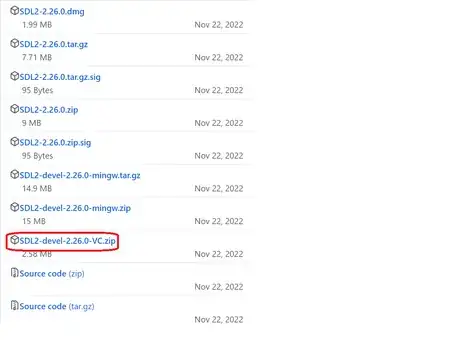
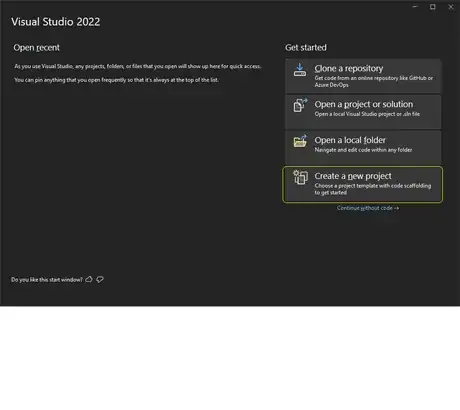


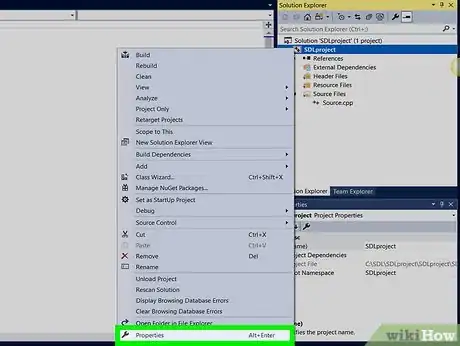

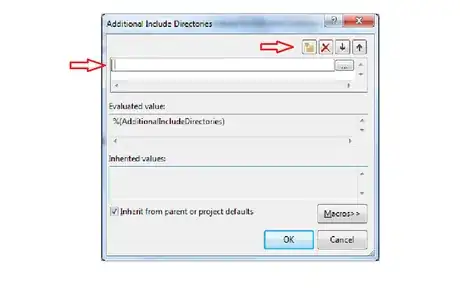

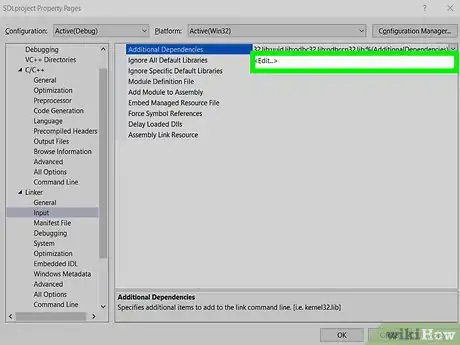
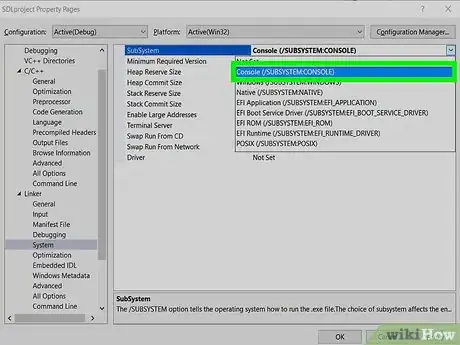

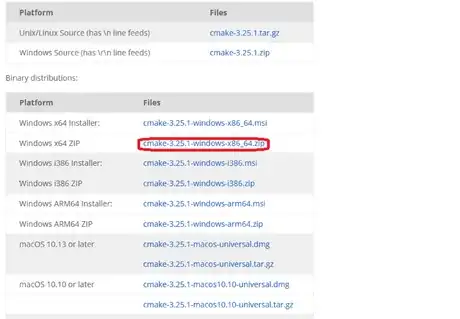
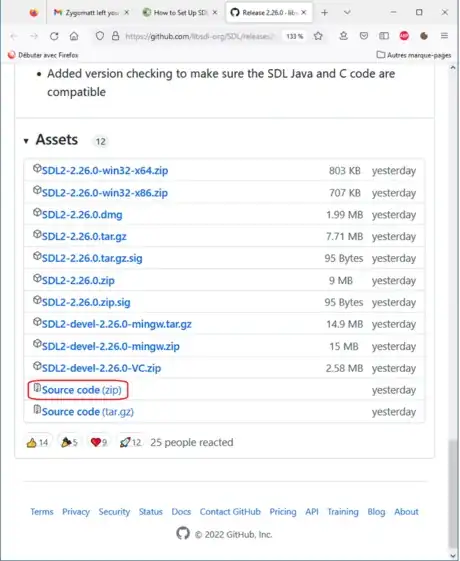

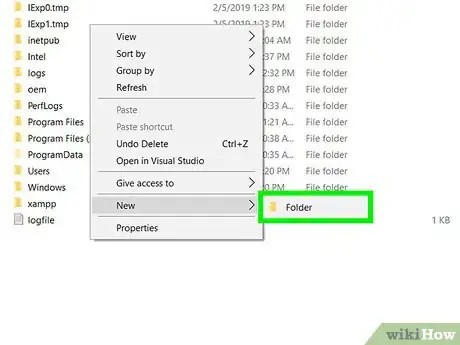
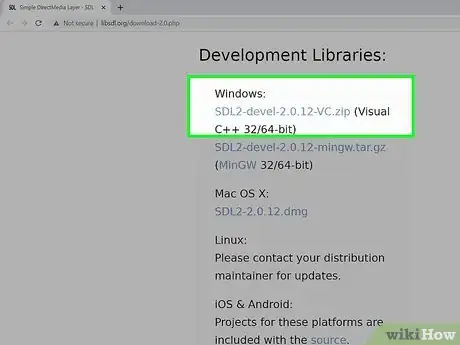


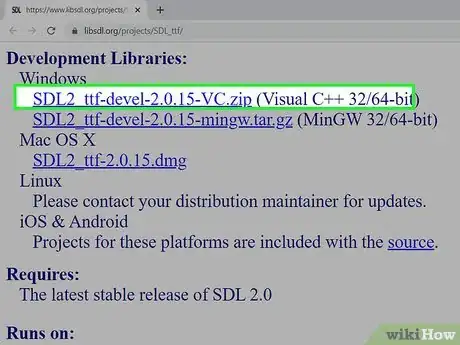





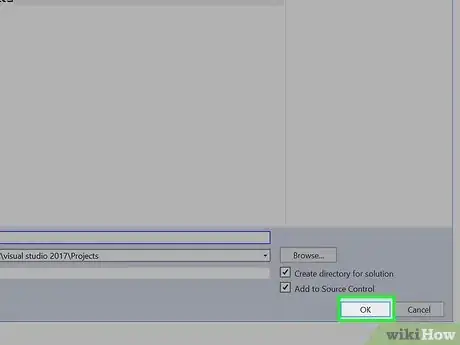
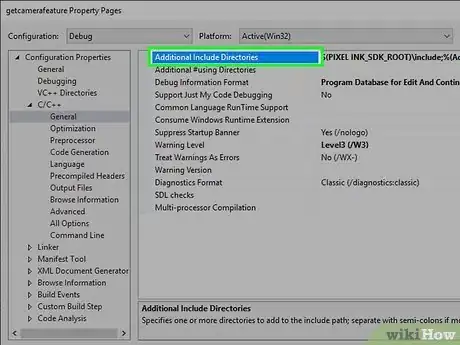
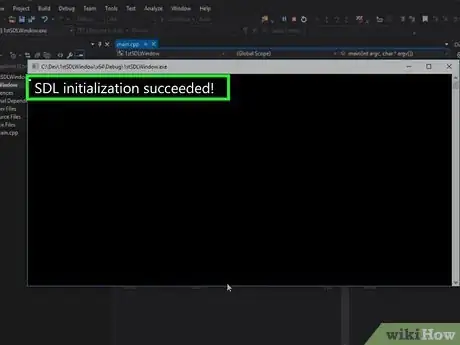

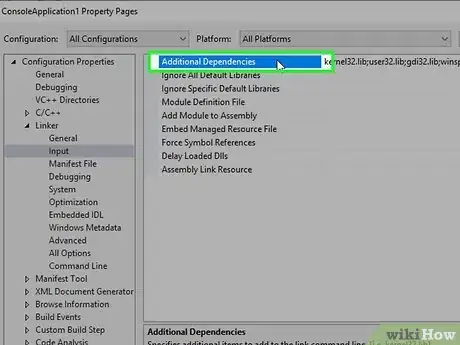
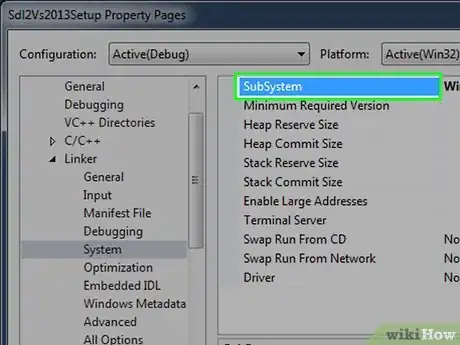

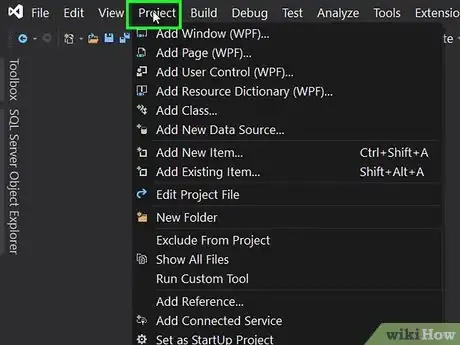
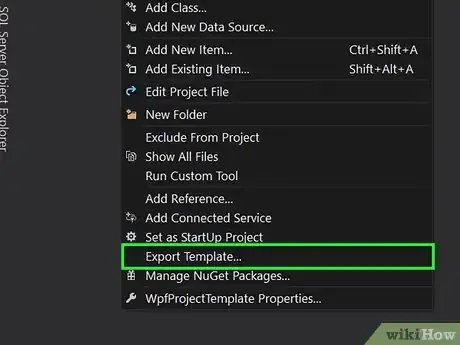

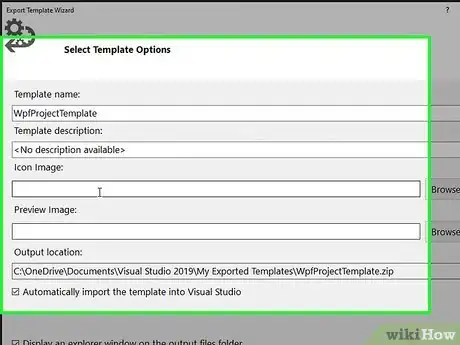
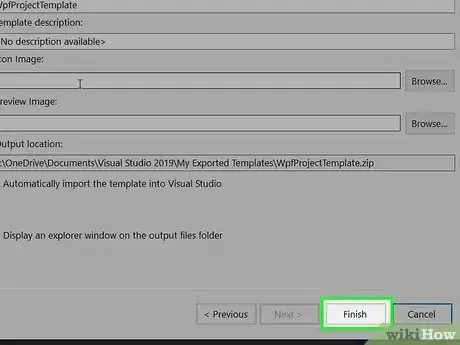
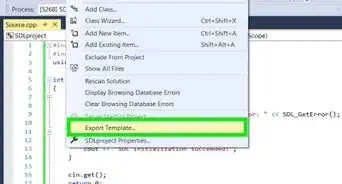
-Step-16-Version-3.webp)
